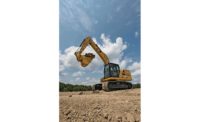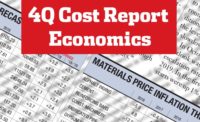Surpassing even the most optimistic expectations of industry observers, sales of construction equipment are on pace to record double-digit growth for 2018, providing welcome momentum in the face of looming uncertainties about the market’s long-term prospects.
With demand for new equipment already benefitting from an overall strong economy, the federal tax law’s provision of 100% first-year bonus depreciation for new assets “threw gas on the fire,” observes Steve Tam, vice president of ACT Research. He predicts 2018 truck sales will finish around 68,000 units, a 13% increase from 2017 and double his original forecast made last December. Tam adds that while equipment demand may be at or near its peak, contractors see opportunities continuing into 2019, at least for now. “They’re confident,” he says, “and confident consumers spend money.”
Chris Sleight of U.K.-based marketing consultant Off-Highway Research likewise foresees a 13% increase in North American equipment sales, with key drivers being continued state and local infrastructure spending. A shift from what has been a potent residential market to increased activity in other sectors should help sustain sales, Sleight adds, although the prospect of price increases and other impacts resulting from the Trump administration’s tariff and trade battles “can only be a negative.” Tam agrees, adding that while the current pause in the China trade dispute provides “another quarter for the market to have legs,” the potential of new restrictions is a concern.
“Strong, but with a warning,” is how Association of Equipment Manufacturers president Dennis Slater characterizes many manufacturers’ recent earning reports. He says machine builders now recognize that because trade issues may not be easily resolved, “they have to plan for impacts longer than just a few months.”
|
Related Link |
Offsetting Headwinds
Manufacturers such as Caterpillar and John Deere have already announced price increases for 2019. Speaking at Credit Suisse’s 2018 Industrials conference last month, Amy Campbell, Caterpillar’s director of investor relations, said the firm’s planned 1% to 4% hike “will offset all the cost headwinds—tariffs, materials, inflation and any kind of labor inflation.” She added that for most of the past ten years, North American equipment sales have still tracked below the 30-year trend. “We’ve had a pretty a tough middle of the decade,” she said. “We’ve finally gotten back to healthy construction sales levels.”
But with tariff-related steel price increases likely affecting other elements of the economy, manufacturers may well be unable to pass along the entirety of their price pressures to customers. “They’ll have to eat some of it,” Slater says.
Even if mutually amicable outcomes to the trade issues are achieved, observers believe a long-expected cooling of the nation’s protracted post-recession construction boom could become evident toward the end of 2019. Tam predicts flat sales for trucks over the next 12 months, with month-over-month demand gradually ebbing toward a “more meaningful softening” of the economy in 2020.
High backlogs should keep manufacturers busy for the near term, however. “There’s only limited capacity for new orders,” Tam says. Sleight notes that fracking and other domestic energy production activity may at least partially offset any economic downturns in other sectors. So too could a federal infrastructure bill that observers believe could be revived in the new Congress. Sleight expressed doubts about that prospect, however. “We’re not holding our breath,” he says.
Brian McGuire, CEO of Associated Equipment Dealers, says buying in 2019 will hinge more on need rather than availability of telematics and other new features. If the equipment is used 75% to 80% of the time, “they’ll buy instead of rent,” he says. “That’s the biggest driver.”
Any changes in user habits have yet to be felt by companies such as Sunbelt Rentals. Revenue for the Ft. Mill, S.C., firm increased 18% in its fiscal half-year that ended Oct. 31. In an earnings call, Michael Pratt, financial director of the firm’s U.K.-based parent, Ashtead Group, said Sunbelt benefitted from generally strong end markets and to a lesser degree impacts of 2017 U.S. hurricane cleanups.
If 2019 fulfills expectations of modest growth in equipment sales, manufacturers may well perceive such results differently than in the past. “The market is slowing, but it’s a return to ‘normal’ after several years of record levels,” Tam explains. “We’ll see how acceptable that is.”





Post a comment to this article
Report Abusive Comment